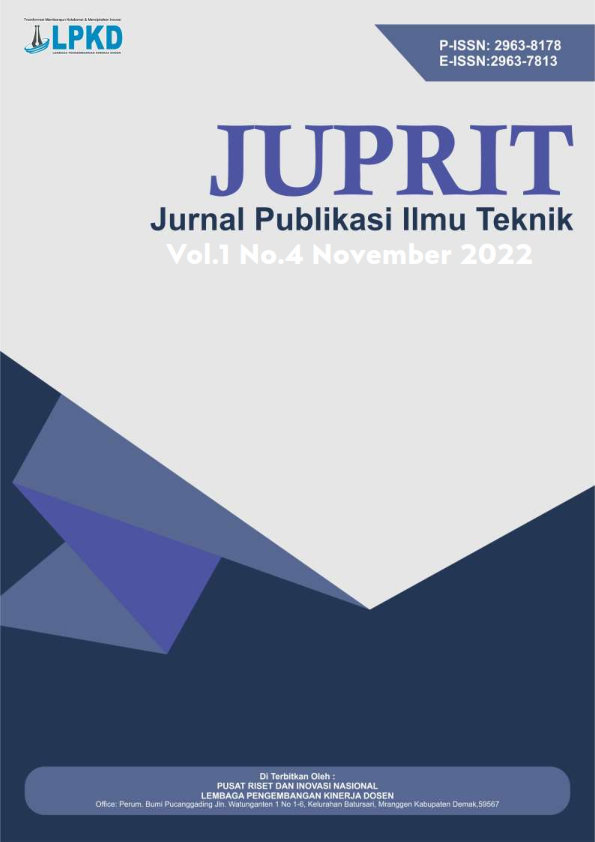Re-Layout Tata Letak Bagian Percetakan Menggunakan Calullar Manufacturing System
DOI:
https://doi.org/10.55606/juprit.v1i4.613Keywords:
Facility layout, Material handling, Cellular manufacturing system, Sorting Based AlgorithmsAbstract
Material handling in the production division of publisher X encountered several obstacles, including the transfer of material between production processes having cross-movement flows. This condition occurs as a result of an irregular engine layout. The impact of the conditions in the transfer of material in the production process is the distance of the transfer to be 968.6 m/day. This condition causes some machines to be repositioned, so that material transfer can run faster and more efficiently. One of the efforts to reduce material transfer is to re-plan the placement of production facilities by adopting the concept of a cellular manufacturing system or cellular manufacturing system that is feasible to be applied to the production process of publisher X. The cellular manufacturing system was chosen because it is in accordance with the number of characteristics of the publishing industry that requires the ability to anticipate changes. This rapid demand suits a particular market. This article describes how the results of rearranging and minimizing the distance of moving raw materials in the production section of publisher X by adopting the concept of a cellular manufacturing system and rearranging the layout of production facilities by using sorting using Sorting Algorithms. The selection of the Sorting Algorithms is based on consideration of the order of the output which is not coherent, so it needs to be sorted. Efficient sorting is needed to determine the part-machine incidence matrix which is then used in the development of cellular manufacturing systems. Program development on Visual Studio 2012 software shows the results of facility layout planning by grouping 20 machines and 11 products with this layout change, the total material handling distance is reduced by 371.8 m or by 61.61%
Downloads
References
Aiham Kadhim Alshakarchi, D., & Salman azeez, M. (2017). Plant layout design and assessment consideration of cellular manufacturing system via G.A. Journal of Al-Qadisiyah for Computer Science and Mathematics, 9(2). doi:10.29304/jqcm.2017.9.2.315
Alimian, M., Ghezavati, V., & Tavakkoli-Moghaddam, R. (2020). New integration of preventive maintenance and production planning with cell formation and group scheduling for dynamic cellular manufacturing systems. Journal of Manufacturing Systems, 56. doi:10.1016/j.jmsy.2020.06.011
Bao, W., Kong, F., & Che, H. (2016). Design model of cellular manufacturing system under the constraint of cost and delivery reliability. RISTI - Revista Iberica de Sistemas e Tecnologias de Informacao, 2016(E10).
Bhangale, J. H., & Mahalle, A. M. (2014). Reengineering the Layout: A CMS Methodological Approach. SAE International Journal of Materials and Manufacturing, 7(3). doi:10.4271/2014-01-9100
Bortolini, M., Galizia, F. G., Mora, C., & Pilati, F. (2019). Reconfigurability in cellular manufacturing systems: a design model and multi-scenario analysis. International Journal of Advanced Manufacturing Technology, 104(9–12). doi:10.1007/s00170-019-04179-y
Dimopoulos, C., & Zalzala, A. M. S. (2000). Recent developments in evolutionary computation for manufacturing optimization: Problems, solutions, and comparisons. IEEE Transactions on Evolutionary Computation, 4(2). doi:10.1109/4235.850651
Goyal, K. K., Jain, P. K., & Jain, M. (2013). A comprehensive approach to operation sequence similarity based part family formation in the reconfigurable manufacturing system. International Journal of Production Research, 51(6). doi:10.1080/00207543.2012.701771
Hachicha, W., Masmoudi, F., & Haddar, M. (2008). Formation of machine groups and part families in cellular manufacturing systems using a correlation analysis approach. International Journal of Advanced Manufacturing Technology, 36(11–12). doi:10.1007/s00170-007-0928-9
Hamza, S. A., & Jehad, A. (2019). HEURISTIC METHOD FOR SOLVING CELL FORMATION PROBLEM IN CELLULAR MANUFACTURING SYSTEM BASED ON HAMMING DISTANCE. THE IRAQI JOURNAL FOR MECHANICAL AND MATERIALS ENGINEERING, 19(1). doi:10.32852/iqjfmme.v19i1.267
Hooshyar Telegraphi, A., & Bulgak, A. A. (2021). A mathematical model for designing a reliable cellular hybrid manufacturing-remanufacturing system considering alternative and contingency process routings. SN Applied Sciences, 3(3). doi:10.1007/s42452-021-04315-y
Khaksar-Haghani, F., Kia, R., Mahdavi, I., & Kazemi, M. (2013). A genetic algorithm for solving a multi-floor layout design model of a cellular manufacturing system with alternative process routings and flexible configuration. International Journal of Advanced Manufacturing Technology, 66(5–8). doi:10.1007/s00170-012-4370-2
Kia, R., Baboli, A., Javadian, N., Tavakkoli-Moghaddam, R., Kazemi, M., & Khorrami, J. (2012). Solving a group layout design model of a dynamic cellular manufacturing system with alternative process routings, lot splitting and flexible reconfiguration by simulated annealing. Computers and Operations Research, 39(11). doi:10.1016/j.cor.2012.01.012
Kia, R., Khaksar-Haghani, F., Javadian, N., & Tavakkoli-Moghaddam, R. (2014). Solving a multi-floor layout design model of a dynamic cellular manufacturing system by an efficient genetic algorithm. Journal of Manufacturing Systems, 33(1). doi:10.1016/j.jmsy.2013.12.005
Potdar, G. C., Sapkal, S. U., & Shivade, A. S. (2021). Modified direct clustering algorithm for group formation in cellular manufacturing. IOP Conference Series: Materials Science and Engineering, 1049(1). doi:10.1088/1757-899x/1049/1/012019
Rabiei Hosseinabad, E., Adib, M., & Zaman, U. (2020). A Brief Review on Cellular Manufacturing and Group Technology. Research Journal of Management Reviews, 5(1).
Saxena, L. K., & Jain, P. K. (2011). Dynamic cellular manufacturing systems design - A comprehensive model. International Journal of Advanced Manufacturing Technology, 53(1–4). doi:10.1007/s00170-010-2842-9
Shafiee-Gol, S., Kia, R., Kazemi, M., Tavakkoli-Moghaddam, R., & Mostafayi Darmian, S. (2021). A mathematical model to design dynamic cellular manufacturing systems in multiple plants with production planning and location–allocation decisions. Soft Computing, 25(5). doi:10.1007/s00500-020-05417-2
Su, T. S., & Hsiao, H. H. (2021). Developing a fuzzy-set-based shortcut layout approach for a semiconductor inter-bay handling system. International Journal of Advanced Manufacturing Technology, 115(3). doi:10.1007/s00170-020-06150-8
Tavakkoli-Moghaddam, R., Rabbani, M., & Iman-Eini, M. (2004). Solving manufacturing cell formation problems in dynamic and stochastic states by a hybrid method. Amirkabir (Journal of Science and Technology), 15(58 D).
Wemmerlöv, U., & Hyer, N. L. (1986). Procedures for the part family/machine group identification problem in cellular manufacturing. Journal of Operations Management, 6(2). doi:10.1016/0272-6963(86)90021-5








